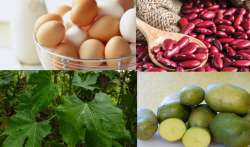10 foods and liquids to consume during 'Chikungunya'
Chikungunya is a viral disease which causes fever and severe joint pains. These are accompanied with nausea, headaches and body rash. The basic rule to fight any infectious disease is proper nutrition and hydration.

Chikungunya is a viral disease which causes fever and severe joint pains. These are accompanied with nausea, headaches and body rash. The basic rule to fight any infectious disease is proper nutrition and hydration.
Our body burns more calories when we have fever, resulting in lack of energy in the absence of appropriate consumption of food. Also, our immune system needs help to recover fast and fight the infection.
Thus, it is important that we the individual suffering from chikungunya is kept well-nourished. What amplifies the problem is that the feeling of nausea is frequently accompanied with fever and the patient doesn’t like the taste of water and food.
There is a need to be creative with food and think of options which can be consumed by a patient. Here are 10 such foods and liquids:
1. Water: Encourage the patient to drink a good amount of water so that the infection can be washed away. If the individual doesn't like the taste of plain water, you may give juice, lemonade, coconut water. In fact, adding some fruit squash or tang is also fine. This way, at least you can allow the person to have some energy and feel good.
2. Soups: You may give a nice mixed vegetable soup or chicken soup. Try to give fresh home made soup and avoid the packaged ones.
3. Herbal tea: A nice home made herbal tea, made by using 1 cup water, ½ tsp each of fennel seeds (sunaf), caraway seeds (ajwain) and cumin seeds (jeera), helps to relieve the joint pain. You just need to boil the water with the these seeds for 3-4 minutes or till the water remains to ¾ th cup, sieve and serve hot. May add sugar/ jaggery or honey if required. Even water boiled with cumin seeds helps to reduce the muscular and joint pain.
4. Fruits: Individuals, especially children and adolescents usually go off food as they do not like the taste of vegetables when having high fever. Encourage them to have fruits like apple, mausami, pear, banana, papaya etc.
5. Salads: It is fine to give salads including carrots, cucumber and some greens with some lemon to help boost immunity.
6. Biscuits: Children, if unwilling to eat chapatti or bread, can be given biscuits of their choice, so that they don’t lose energy. The main focus at this time should be to keep the child or individual nourished. A piece of cake if they can eat happily is good. Once they feel better, you can bring them back to healthy eating patterns.
7. Rice, Porridge, chapatti: You can create a variety of foods by mixing lentils and rice or vegetables and porridge to make nice healthy tasty dishes. Make nice paneer rolls with chapatti. The food should not be monotonous just because the person is ill. Including good variety and presentation would encourage the individual to eat.
8. Add healthy oils: Add ghee or coconut oil to the food, when the person is willing to eat normal food. May add flaxseed oil over salads to encourage omega-3 intake to reduce inflammation. Cooking in mustard and canola oil is also beneficial.
9. Avoid too much of sweet: It is fine to take a few sweet things or even a candy to replenish energy during high fever, but do not overdo the sweets as it may not allow the immune system to strengthen.
10. Herbs: Chewing Tulsi leaves benefits in bringing down the fever and strengthen immunity.
(The author is a Metabolic balance coach & Sr. nutritionist, AktivOrtho)